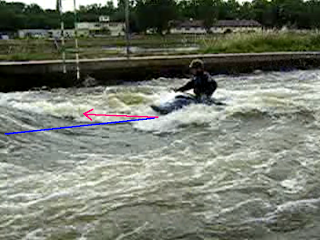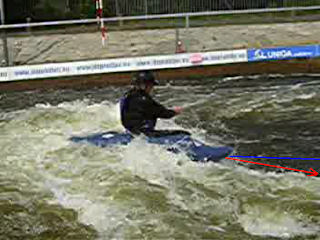So after a long time I found enough determination to write something new... I ve been out of the WW business for over 2 months so sorry for not having attended the site for such a long time.
Anyway... First of all this article is for those who have started the difficult path of C1 freestyle. The roundhouse is a way to have fun even on small and/or shallow waves. If you want to learn blunts someday the roundhouse is a good start to improve your stability and general behavior on small waves before you try bigger ones.
Roundhouse is basically a low angle blunt (or even more basically slightly angled dynamic half-flatspin)performed on the green water (the part of the wave not covered by foam).
To get the general idea how it looks like watch this video.
The first important thing about the roundhouse as well as any wave maneuver is to get up the wave to the top. I already wrote an article on this see: here
DO NOT attempt to do a roundhouse while surfing on the green water without any upstream speed because you will not learn how to get the speed without losing balance which is MOST important for a C1er to progress to more difficult moves.
Phase 1:
So now you are somewhere up the wave. The first important thing is the angle of the descent to the green water where you want to do the move. There is a comprehensible rule for that: If you want to do a right roundhouse "aim" your boat slightly to the left and consequently in case of a left roundhouse you go slightly to the right.



Phase 2:
Now you are descending down the wave. Since we are talking about small waves it wont be much of a descent...:)) But you need to get as much speed as possible.
Here comes the first problem of the onside roundhouse/blunt. You cant use a paddle stroke for higher speed like the kayakers do because it would a) get you out of balance b) affect the onset angle c) move your paddle backwards where you cannot use it for the rotation. However you can plant a stroke while still on the foam pile but such a stroke wont affect the speed much... You can increase the speed by leaning forward dynamically on the foam pile.
The second important thing is the "edge transition" which simply means that you firstly engage left edge of the boat for a right blunt and right for the left. You engage the respective edge by pushing it into the water (your weight on the respective edge) while the other edge stays out of water. The body position at this stage should be neutral (no leaning forward at this stage!! The weight shift should be done by pushing by the respective knee and tilting the boat a bit).
Phase 3: IMPORTANT
Then when you ve felt the strength of the water forcing the boat into a carve/turn to the respective side you have to change the edges fiercely. This creates enough energy to do the roundhouse. As you change the edges you also plant the paddle (you actually lean on the paddle thus changing the edges). You should plant your paddle somewhere near your hips. The closer to the boat you plant it the more vertical the move will be (but also the more demanding as far as strength and dynamics is considered.) Body position- lean aggressively forward just as the boat starts to turn to your onside (on bigger waves while doing air blunts it should be backwards..)

Onside edge engaged. Paddle position indicated
Phase 4: The rotation
One of the mistakes I used to make was that I simply thought that during the rotation I shoul apply the strength just as during the bow end of the onside cartwheel. During the cartwheel you should apply the strength continually but during wave maneuvers you must pack all the strength in one dynamic impulse (if you don t you usually end up with a washout...). Your paddle serves as a pivot point of the rotation.
One of the mistakes I used to make was that I simply thought that during the rotation I shoul apply the strength just as during the bow end of the onside cartwheel. During the cartwheel you should apply the strength continually but during wave maneuvers you must pack all the strength in one dynamic impulse (if you don t you usually end up with a washout...). Your paddle serves as a pivot point of the rotation.
This is the most problematic phase of any onside wave move. If a kayaker does a blunt he may use the second blade for the "recovery" stroke thus regaining balance and staying on the wave. What often happens in a C1 is that you lose your balance after completing the rotation and you fall to your offside like a bag of shit...
There are three basic strategies how to avoid losing balance.
A) You move the paddle to your offside and use it as a backwards rudder. Tip: shift your hand that holds the paddle up the shaft as you complete the rotation before trying to use it to regain balance. Another tip: If you feel dragged to your offside by the water pushing against the blade let go of the shaft!! Then fling the arm to your onside- this often saves the day... can be seen in the video above...
B) Hand stroke. This technique is more advanced. You simply do the recovery stroke with the palm of the hand on the T-grip just as the kayakers do their stroke with a paddle. I personally use a combination of these two techniques. You can see it in the video.
















No comments:
Post a Comment